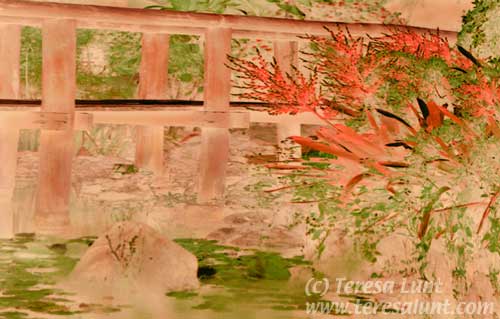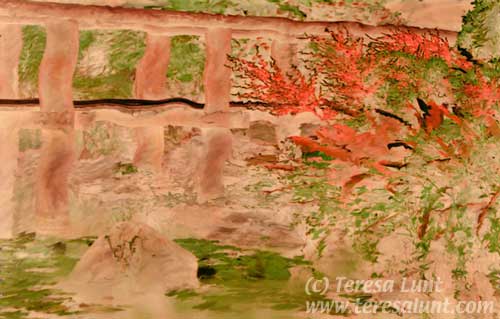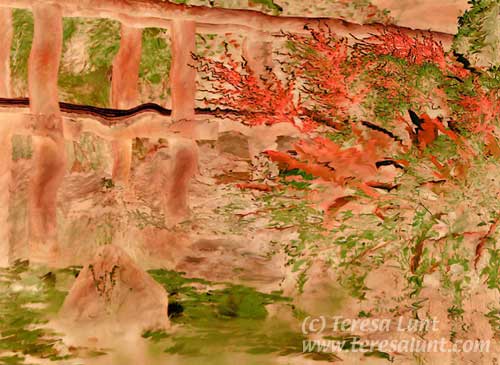|
|
|
Tutorial 2: Bridge and Lilypads In Tutorial 1 I showed you how to turn an ordinary photograph into a painterly version of that photograph. But the power of our digital tools allows us to get much more creative than that. Here I will talk about how we can completely transform a photograph into something quite different. The viewer may be surprised to know the work is actually a manipulated photograph! From this example you can get an idea of the variety of art you can create using these tools. The scan is at 2400 dpi. (You should scan at a minimum of 1800dpi for 35mm slides or negatives. You can scan at much lower resolutions for prints.) Figure 1 shows the scan I took of the color slide after making initial exposure corrections in Photoshop to match the slide as closely as possible. You can make these adjustments in any image editing software. |

|
The parts of the image that are interesting to me are the lilypads and rocks in the water, the bridge, and some of the reddish foliage. But there is too much foliage, it looks too visually complex, and it distracts the eye. So I will crop some of it out. I choose my cropping point to keep some of the green bush in the upper right corner, otherwise there would be a black hole there in the corner which might tend to pull the eye. |

|
Now compare Figure 2 to the original composition in Figure 1 and you will see that the interesting water part of the image is much more prominent. The compressing that we did also emphasizes the diagonal lines of the red foliage, which is another interesting compositional element. Notice how those red diagonal lines are now at a steeper and more interesting angle. |

|
Figure 3 is pleasing, but I was after something more artistic. The image is too literal for me, and overall the image has too many dark areas. I needed some radical alterations. I know that inverting the image will replace dark areas with light areas, while the middle greens and reds will generally keep their same brightness. But inverting a color image also inverts all the colors. I don’t want to invert the colors, so I do the following. . |

|
If you compare the original with the final image, you can see that we took a rather ordinary image and made it into a piece of art!Then I experimented with color alterations in Channel Mixer. Channel Mixer can produce extreme and unexpected color changes, so you want to experiment and make small changes to try different effects. Here I used Channel Mixer to boost the red a bit and reduce the green and blue just a bit. I also used the burn tool at a very low opacity to darken the rock and the bridge a bit. Burning also deepens the color in that region. Figure 5 shows the results of the image inversion and color adjustments. Now the image is starting to look something like a woodblock print. The image has been simplified by reducing its color palette to just red and green, and replacing the dark areas with light areas. |

|
Now I wanted to add some interest by introducing distortion. Distortion is one of my favorite effects. I often use it to create an almost hallucinatory feeling. (You can see lots of examples of this at my website.) Here I used a pen input device and Wacom tablet to draw in some distortion. For this I used the Photoshop plug-in software that came with the tablet, specifically the Super Putty tool, to use the pen to push pixels around. I used the smallest stylus setting in that tool to make the most fine-grained effects. The tablet is pressure sensitive, so you can increase the effect by increasing the pressure. |

|
Next I added some finishing touches by deepening shadows and darkening some areas, and highlighting other areas. I also increased the contrast a bit. These kinds of final adjustments can really bring out a feeling of depth in an image. |

|
If you compare the original with the final image, you can see that we took an unremarkable photograph and transformed it into a work of art! |
![]()
